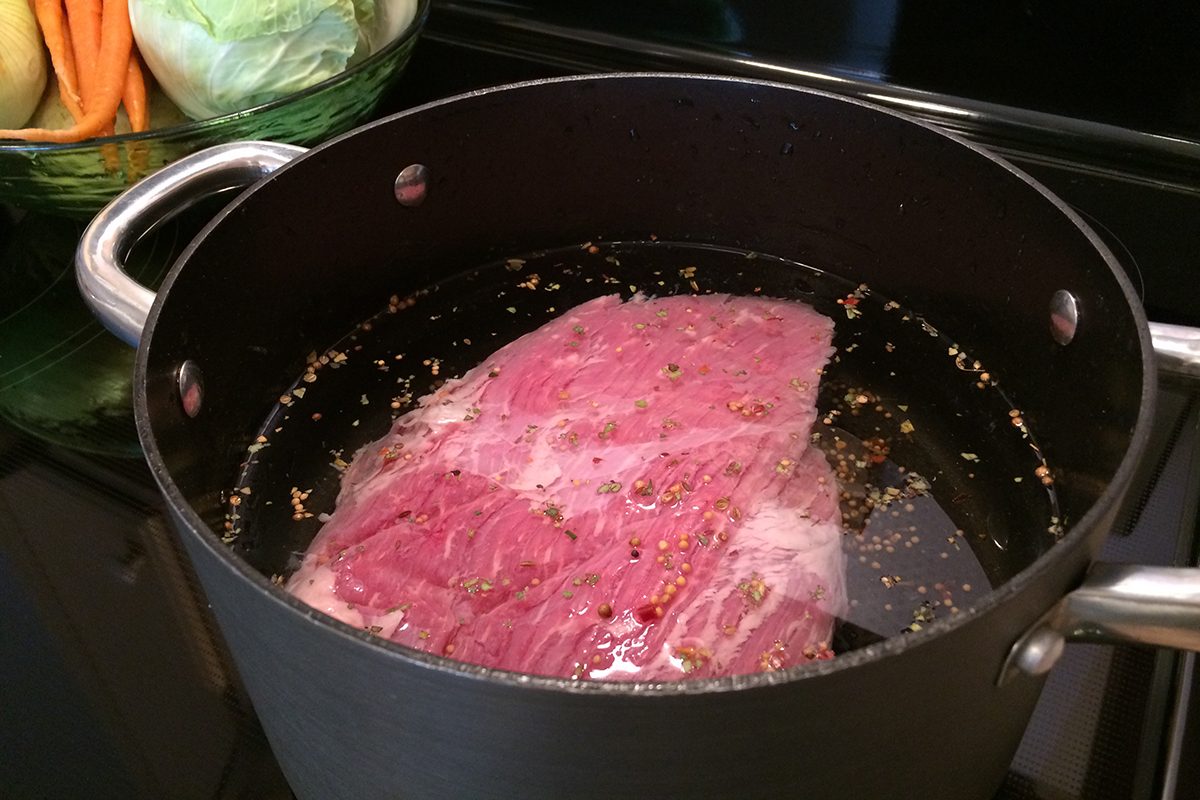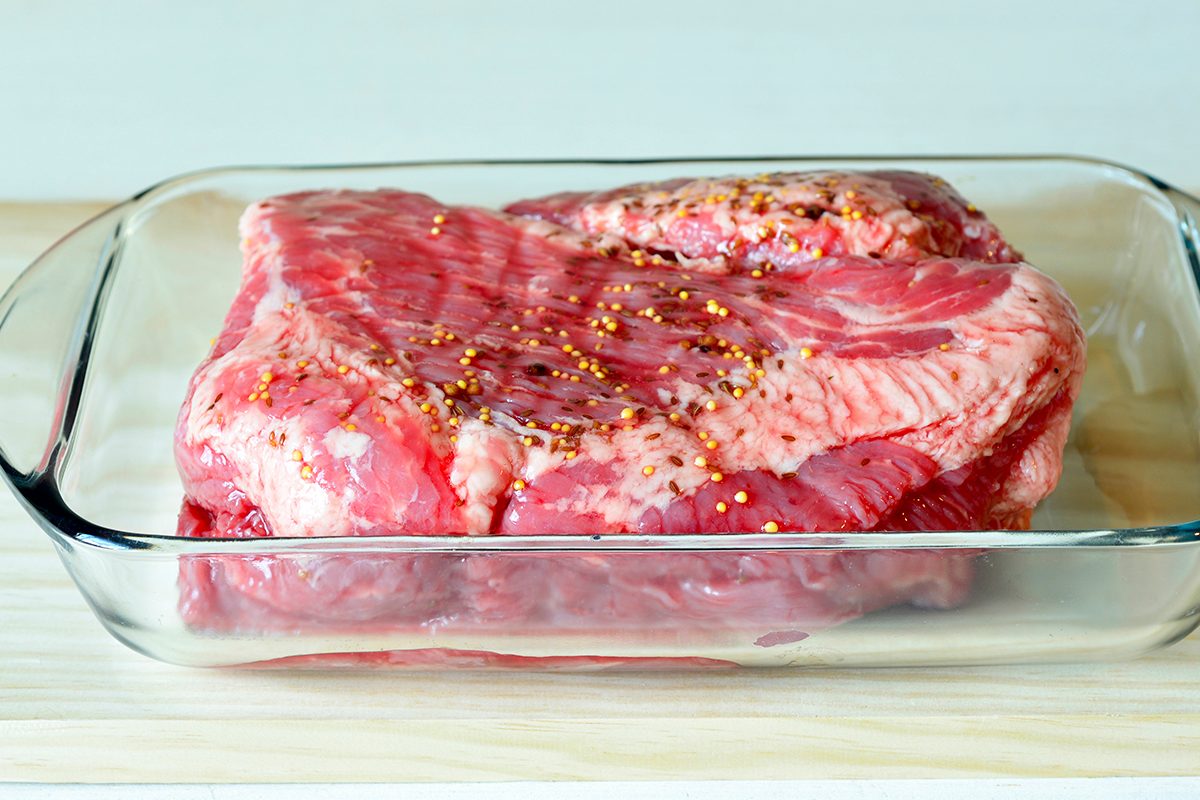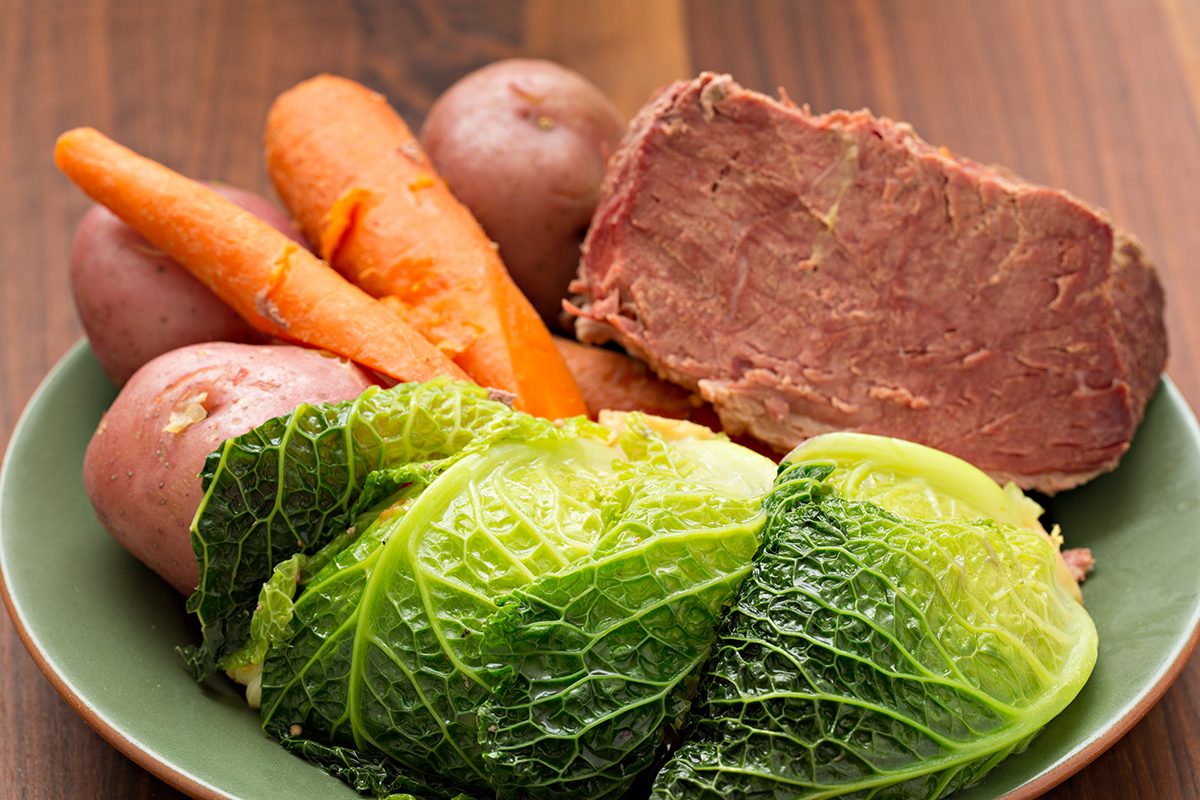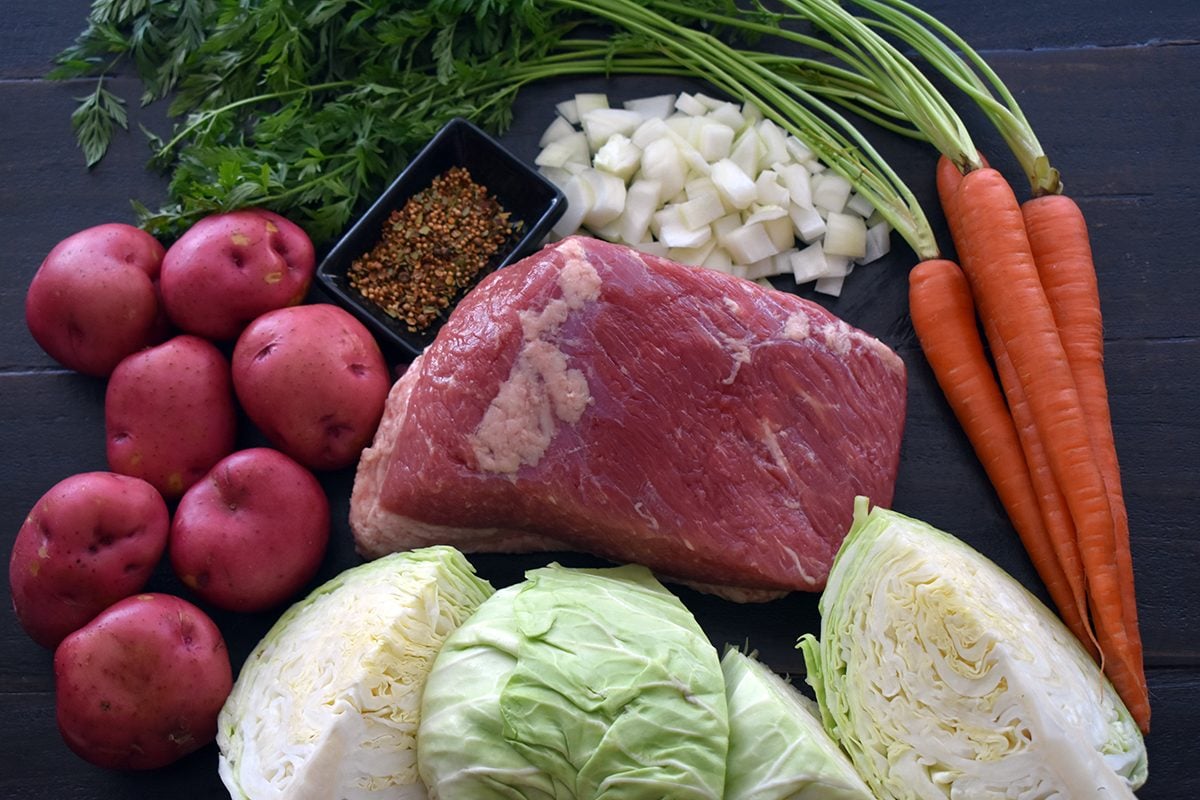Corned beef isn’t exactly a tradition that has a lot of variation: It usually turns out tasting the same year after year. Of course, we love that same-old flavor, so we don’t usually complain! We’ve still managed to have fun with it over the years, making corned beef brisket from scratch to reduce the salt content and smoking corned beef to give it a pastrami-like flavor. So why not try making a baked corned beef instead of a boiled one?
Cooking the corned beef in a tightly sealed roasting pan with water ensures the moisture gets trapped inside the brisket, resulting in one of the best corned beefs we’ve ever tried.
How Do You Cook Corned Beef in the Oven?
Step 1: Blanch
Before you bake the corned beef, we recommend blanching it briefly in boiling water. Corned beef is cured in salt, and simmering it will help draw out some of that salty flavor. Start by rinsing the excess salt from the corned beef and placing it in a large pot. Add enough water to cover the meat and bring it to a boil over high heat. When the water starts to bubble vigorously, discard the water and pat the corned beef dry.
Step 2: Bake
Meanwhile, preheat the oven to 350°F. Place the corned beef fat-side up in a roasting pan with a rack or use an oven-safe rack set inside a rimmed baking sheet. If you don’t have either, set the corned beef on top of a bed of chopped onions so it’s elevated from the pan. Feel free to rub the top of the corned beef with Dijon mustard and seasonings, or you can keep things simple and roast it as-is.
Add 1/2-inch water to the roasting pan and tightly wrap the pan with aluminum foil. Bake 2 to 3 hours (depending on the size of the brisket), until the meat reaches an internal temperature of 195°. Check the pan occasionally to ensure it still contains water.
Step 3: Add vegetables (optional)
To make an easy side dish, add potatoes, carrots and onions to the pan for the last hour, placing them below the rack with the corned beef. To complete the meal, serve the meat and vegetables with a side of fried cabbage.
Step 4: Broil (optional)
To create a crispy crust on the top of the brisket, remove the aluminum foil after the brisket reaches the desired temperature. Set the broiler on high and cook for 2 to 3 minutes, until the top is golden brown and crispy.
What Temperature Do You Cook Corned Beef in the Oven?
We like baking corned beef in a 350° oven. You can go as low as 275° (the temperature we recommend for smoked corned beef), but it will take an extra hour or two to finish.
How Long Do You Bake Corned Beef Per Pound?
As a general rule of thumb, corned beef takes about an hour per pound to bake. The best way to know for sure when your corned beef is finished is to use an instant-read meat thermometer. Probe the corned beef in the thickest part of the meat, and the alarm will go off when it’s finished.
We like 195° for a super-tender, flaky corned beef, but you can pull the meat when it reaches 180° if you prefer firm (but still tender) slices. Either way, let it rest for at least 30 minutes before slicing it against the grain and serving.
Should You Boil or Bake Corned Beef?
Really, it’s up to you. Both methods create a juicy, tender corned beef when done properly. Traditional corned beef recipes call for simmering corned beef in spiced water for about three hours. We like this method because the water creates a moisture barrier that keeps the beef from drying out, but it’s also easy to accidentally boil too vigorously, creating tough pockets in the meat.
Baked corned beef, on the other hand, requires a two-step process—blanching then baking—but the higher oven temperature also reduces the cooking time by about an hour. We also like having the option of broiling the cooked brisket at the end, developing an unforgettable crispy crust that’s hard to beat.
Bottom line: If you’re a traditionalist, go ahead and keep boiling away, but baked corned beef is definitely worth a try if you’ve never done it. Either way, you’ll end up with a ton of tasty leftovers!

Corned Beef Hash Rustic Pie
This suppertime pie has all the yummies: homemade crust, seasoned potatoes, and lots and lots of corned beef and cheese. How could you not fall in love with it? I know we have. —Colleen Delawder, Herndon, Virginia
Reuben Pudgy Pie
Our favorite pudgy pie is the Reuben: corned beef, sauerkraut and Swiss cheese! We always use buttered bread. —Taste of Home Test Kitchen
Corned Beef Pizza Swirls
You don't have to wait until St. Patrick's Day to enjoy this easy Reuben appetizer. Deli meat and cheese make it doable year-round. —Colleen Delawder, Herndon, Virginia
Spicy Corned Beef Tacos
Using leftovers in new and exciting ways is my personal cooking challenge. These fun tacos take my favorite Reuben ingredients and turn them into something totally different—and completely delicious. —Fay Moreland, Wichita Falls, Texas
Reuben Spread
You'll need only five ingredients to stir up this hearty dip that tastes like a Reuben sandwich. It's requested at all the gatherings we attend. —Pam Rohr, Troy, Ohio
Makeover Hash and Eggs
Who knew there was such a thing as healthy corned beef hash?! Loaded with red potatoes and deli corned beef, our lightened-up version of corned beef hash delivers fresh flavors and a dose of fiber. It's so spot on, you'll swear you're in a diner. —Taste of Home Test Kitchen
Reuben and Rye Strata
This make-ahead dish is so easy to prepare. It's wonderful for brunch, lunch or supper, or as a potluck meal. If you prefer it, substitute turkey pastrami for the corned beef. —Mary Louise Lever, Rome, Georgia
Reuben Waffle Potato Appetizers
I love Reubens, so I turned the classic sandwich into a fun appetizer with corned beef and sauerkraut on waffle fries. —Gloria Bradley, Naperville, Illinois
Meal in a Muffin Pan
This meal-in-a-pan breakfast is ideal for busy weekday mornings. I just add fresh fruit and beverages. —Michelle Plumb, Montrose, Colorado
Slow-Cooker Reuben Spread
My daughter shared this recipe with me for a hearty spread that tastes just like a Reuben sandwich. Serve it from a slow cooker set to warm. —Rosalie Fuchs, Paynesville, Minnesota
Reuben Pizza
Fridays are pizza nights at our house. We do a lot of experimenting, so we don't have the same, old thing every week. With only five ingredients, this pizza is a snap to whip up, and it tastes just like a Reuben sandwich. —Nicole German, Hutchinson, Minnesota
Reuben Brunch Bake
I created this when I wanted something different for a graduation brunch for two of our sons. When I realized I had most of the ingredients on hand for the Reuben dip I usually make, I decided to use them in a brunch casserole instead! Everyone asked for the recipe. —Janelle Reed, Merriam, Kansas
Diner Corned Beef Hash
I created my hash to taste like a dish from a northern Arizona restaurant we always loved. We round it out with eggs and toast made from homemade bread. —Denise Chelpka, Phoenix, Arizona
Toasted Reubens
New Yorkers say my Reubens taste like those served in the famous delis there. For a little less kick, you can leave out the horseradish. —Patricia Kile, Elizabethtown, Pennsylvania
Paddy's Reuben Dip
This slow-cooked spread tastes just like the popular Reuben sandwich. Even when I double the recipe, I end up with an empty dish. —Mary Jane Kimmes, Hastings, Minnesota
Hearty Split Pea Soup
For a different spin on traditional pea soup, try this split pea soup recipe with corned beef. The flavor is peppery rather than smoky, and a tasty change of pace. —Barbara Link, Alta Loma, California
Creamy Corned Beef Casserole
My family really enjoys the flavor of corned beef so I invented this casserole. It is so easy to whip up and your family will love it. —B Overland, Park, Kansas
Reuben-Style Pizza
I love a good Reuben sandwich and thought, “Why not make it into a pizza?” It's got extra cheesy goodness in the sauce, and smells wonderful coming out of the oven. —Tracy Miller, Wakeman, Ohio
Reuben Calzones
I love a Reuben sandwich, so I tried the fillings in a pizza pocket instead of on rye bread. This hand-held dinner is a big winner at our house. —Nickie Frye, Evansville, Indiana
Chicken Reuben Roll-Ups
My Nebraska-native husband loves Reuben sandwiches and anything with chicken, so I combined his two favorites in a fun roll-up. —Ashli Kottwitz, Hermitage, Tennessee
Reuben Rounds
Fans of the classic Reuben sandwich will go crazy for baked pastry spirals of corned beef, Swiss and sauerkraut. They're so easy to make, and bottled Thousand Island dressing makes the perfect dipping sauce. —Cheryl Snavely, Hagerstown, Maryland
Corned Beef Bagel Dip
I've taken this appetizer to many potlucks over the years, and everybody always enjoys dunking bagel bites into the creamy, kicked-up dip. —Shari Stensrud, Cambridge, Minnesota
Baked Reuben Dip
I love a Reuben sandwich, and this recipe combines all of those flavors into a warm and gooey party dip. —Sylvia Metzler, Chillicothe, Ohio
Makeover Reuben Melt
This twist on a classic Reuben keeps the corned beef and uses a sauce made with Swiss (and plenty of thousand-island flavor). Fresh slaw on top replaces the sauerkraut. —Jenni Sharp, Milwaukee, WisconsinThe post How to Make Corned Beef in the Oven appeared first on Taste of Home.
Lindsay D. Mattison




